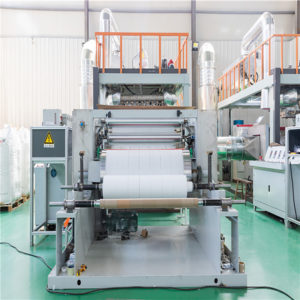There are various real-time monitoring systems and technologies that can be used in the production of meltblown fabric to monitor fiber diameter and uniformity.
Here are a few examples:
Optical Fiber Measurement Systems: These systems utilize optical sensors to measure the diameter and uniformity of individual fibers in real-time. The sensors can be positioned at different points along the production line to capture data continuously. These systems often incorporate image analysis algorithms to process the data and provide accurate measurements of fiber diameter and uniformity.
Laser Triangulation Systems: Laser triangulation systems use laser beams and sensors to measure the distance between the system and the meltblown fabric surface. By scanning across the fabric, the system can generate a 3D profile of the fabric surface, allowing for precise measurement of fiber diameter and uniformity. These systems can provide real-time feedback and are often integrated into the production line for continuous monitoring.
Infrared Thermography Systems: Infrared thermography systems utilize infrared cameras to capture the temperature distribution on the surface of the meltblown fabric. Since fiber diameter and uniformity impact the heat dissipation characteristics, these systems can indirectly assess the fabric quality based on temperature variations. By analyzing the thermal images in real-time, operators can identify any irregularities or deviations in fiber diameter and uniformity.
Air Permeability Monitoring Systems: Air permeability is directly related to fiber diameter and uniformity in meltblown fabric. Real-time monitoring systems can measure the pressure drop across the fabric sample using differential pressure sensors. By continuously monitoring air permeability, operators can detect any variations or deviations in fiber diameter and take immediate corrective actions.
Process Control and Automation Systems: Advanced meltblown machines may incorporate process control and automation systems that monitor and control various parameters in real-time. These systems can collect data from sensors throughout the production line, including temperature sensors, pressure sensors, and flow meters. By integrating these data sources, the system can provide real-time feedback on process conditions and ensure that fiber diameter and uniformity remain within the desired range.
It’s important to note that specific real-time monitoring systems used in meltblown fabric production can vary depending on the equipment and technology employed by different manufacturers. These examples illustrate some commonly used monitoring systems, but there may be other proprietary or customized solutions available in the market as well. Manufacturers of meltblown machines and associated equipment can provide more information on the specific real-time monitoring systems they offer.
How do process control and automation systems help in maintaining fiber diameter and uniformity?
Process control and automation systems play a crucial role in maintaining fiber diameter and uniformity in the production of meltblown fabric. Here’s how these systems help:
Continuous Monitoring: Process control and automation systems continuously monitor key process parameters that influence fiber diameter and uniformity. These parameters may include polymer melt temperature, air velocity, spinneret condition, line speed, and others. By monitoring these variables in real-time, the systems ensure that the process remains within the desired range for optimal fiber production.
Feedback and Control: Real-time monitoring of process parameters enables process control and automation systems to provide immediate feedback to operators. If any parameter deviates from the set limits or the desired range, the system can generate alerts or alarms to notify operators. This enables operators to take prompt corrective actions, china nonwoven fabric machinery manufacturer such as adjusting process settings, modifying machine parameters, or making necessary interventions to maintain fiber diameter and uniformity.
Closed-Loop Control: Some advanced process control and automation systems employ closed-loop control mechanisms. These systems use sensors to measure the actual fiber diameter or related indicators, such as air permeability or surface temperature. The measured values are compared with the desired specifications, and the control system automatically adjusts process parameters to maintain the desired fiber diameter and uniformity. Closed-loop control ensures that any deviations are quickly identified and corrected without operator intervention.
Setpoint Optimization: Process control and automation systems can optimize process setpoints based on historical data and performance analysis. By analyzing data from previous production runs, these systems can identify optimal process settings that result in the desired fiber diameter and uniformity. Over time, the systems can learn from the data and continuously refine the process parameters for improved quality control and efficiency.
Data Analysis and Reporting: Process control and automation systems collect and store data from various sensors and monitoring devices. This data can be analyzed to identify trends, patterns, and correlations between process parameters and fiber diameter/uniformity. The systems can generate reports and visualizations that provide insights into process performance, quality trends, and potential areas for improvement. Operators can use these reports to make informed decisions and implement process adjustments if necessary.
Integration with Quality Control Measures: Process control and automation systems can be integrated with other quality control measures, such as optical microscopy, laser diffraction, or air permeability testing. By combining real-time monitoring of process parameters with direct measurements of fiber diameter and uniformity, these systems provide a comprehensive quality control framework. The integration helps ensure that process adjustments are aligned with the desired quality specifications.
Overall, process control and automation systems provide real-time monitoring, feedback, control, and optimization capabilities to maintain fiber diameter and uniformity in meltblown fabric production. They enhance consistency, reduce human error, and enable efficient and effective quality management throughout the production process.

